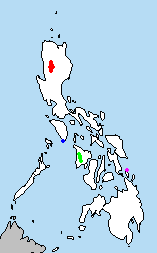Crateromys australis
| Dinagat bushy-tailed cloud rat | |
|---|---|
| Scientific classification | |
| Kingdom: | Animalia |
| Phylum: | Chordata |
| Class: | Mammalia |
| Order: | Rodentia |
| Family: | Muridae |
| Genus: | Crateromys |
| Species: | C. australis |
| Binomial name | |
|
Crateromys australis Musser, Heaney & Rabor, 1985 |
|
 |
|
| Range in pink | |
The Dinagat bushy-tailed cloud rat, Dinagat crateromys or Dinagat cloud rat (Crateromys australis) is a species of cloud rat in the family Muridae. It is one of the eight cloud rats found only in the Philippines, and is specifically endemic to Dinagat Island. It is a rare species. A single specimen was discovered in 1975 by Dioscoro S. Rabor and his team during a scientific survey in Dinagat. The natural habitat is tropical lowland forests, which is facing environmental threats. Habitat loss is caused by progressive deforestation from heavy logging and chromite mining in the area. Due to its rare occurrence and habitat destruction, the species is classified as Critically Endangered by the IUCN Red List in 2008. The assessment noted that the species could have been already extinct. Almost 40 years after the original discovery, five live specimens were discovered by Milada Řeháková, Václav Řehák and William L.R. Oliver, in 2012.
The Dinagat bushy-tailed cloud rat was first seen in 1975 in Balitbiton, Loreto Municipality, Surigao del Norte Province, Dinagat island during a scientific faunal survey. The only specimen (now the holotype) was collected by Dioscoro S. Rabor of the University of the Philippines on 16 May 1975. It was found in a disturbed lowland forest, near a logging road. It was stuffed to preserve its skin, cranium, mandibles and baculum (the penile bone). It was deposited in the American Museum of Natural History. Rabor, with Guy G. Musser of the American Museum of Natural History and Lawrence R. Heaney of the University of Michigan, reported the full description after 10 years, in 1985. (The same survey also resulted in the discovery of other new species of rat, the Dinagat moonrat, Podogymnura aureospinula and later, the Dinagat hairy-tailed rat, Batomys russatus.) The main reason the species is hard to observe is that it is nocturnal and arboreal. No other specimen had been known until 2012. In January 2012, Czech zoologists noticed a living specimen in a semi-protected watershed reserve site on central-north Dinagat. The team led by Milada Řeháková and her husband made a video film of it.
...
Wikipedia

